Content
An application can be a great way to keep your customers engaged and optimize operations. With the right logistics app development, you can offer streamlined benefits ranging from streamlined payment processing to increased customer satisfaction.
Here, we’ll discuss how designing an application for your business might work – breaking down factors like cost and timeline so that you have all of the information needed to make an informed decision. To get started building the perfect mobile app for your company, read on!
Read Also: What Is Cloud Development? The Fundamentals You Need To Know In 2023
What is Logistics App Development?
This is the process of using programming code to create logistics apps that are designed to help businesses optimize their logistics operations. Logistics mobile app development enables businesses to be more efficient by automating logistics processes such as fleet management and route planning. A recent study reports that the digital logistics market worldwide is anticipated to achieve $77.62 billion by 2030, with a Compound Annual Growth Rate of 17.54% from 2021-2030.
Furthermore, logistics app development also helps companies save money by reducing costs associated with manual labor or expensive contracted coordination services. Consequently, logistics app development can give businesses an edge in the competitive global economy by helping them to manage planning operations better and keep costs low.
Different types of logistics apps
In today’s logistics business environment, such apps are a must-have tool for any organization looking to streamline its operations. Logistics apps can help you manage your fleet, track shipments in real time, and even keep your inventory updated.
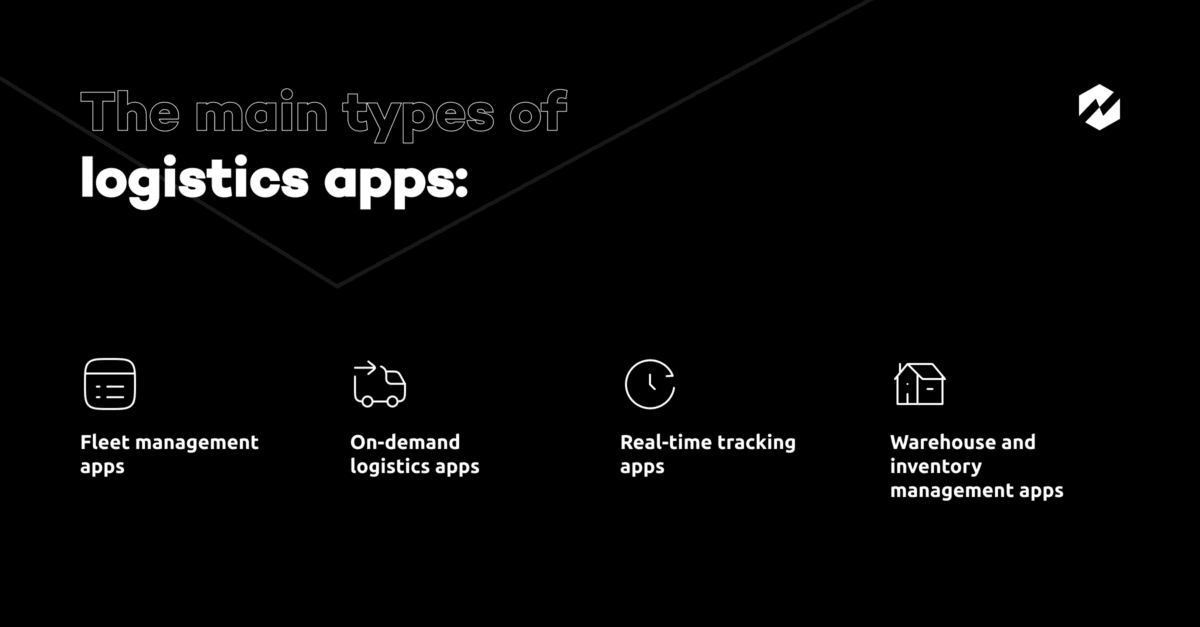

Fleet management apps
These apps are typically used by larger companies that have several vehicles in their fleet. Fleet management apps allow you to track and monitor the location of each vehicle as well as its maintenance schedule. This type of app can also be used to dispatch drivers and provide them with route optimization information. Additionally, it can be used to track fuel consumption and driver performance.
On-demand logistics apps
These apps provide customers with an easy way to order products or services on demand and have them delivered right away. On-demand logistics app is becoming increasingly popular as more people prefer the convenience of ordering something online rather than having to go out and find it themselves. The app will connect customers with nearby providers who can deliver what they need quickly and efficiently.
Real-time tracking apps
These types of apps are extremely useful for businesses that need to keep tabs on their shipments in real-time. Real-time tracking apps allow you to easily track your shipments from start to finish, ensuring that they arrive on time every time. It also gives customers peace of mind knowing exactly where their shipment is throughout the entire process.
Warehouse and inventory management apps
Finally, warehouse and inventory management apps are essential for managing inventory levels in warehouses or other storage facilities. These types of logistics applications enable users to easily check stock levels and order new items when needed without wasting time manually counting stock items or searching through paperwork for orders placed weeks ago. They also provide invaluable insights into customer demand so that businesses can better plan for future purchases or production runs accordingly.
Read Also: How to Build a Service Marketplace Platform? Full Guide with Examples
Top trends in custom logistics app development
With the rise of e-commerce, custom logistics app development has become a booming industry. However, it is important to stay abreast of the latest trends and technologies that are shaping this sector. Let’s look at some of the top trends in custom logistics app development driving the industry forward:
The emergence of augmented reality
Augmented reality (AR) has been a major trend in custom logistic mobile app development over the past few years. AR applications allow users to visualize 3D objects in their physical environment, making them more engaged with their surroundings and increasing productivity. For example, an AR application can be used to generate virtual images on top of a warehouse floor plan for easy navigation.
This can help warehouse workers quickly locate items and make sure they are stored correctly, reducing time spent searching for items and increasing overall efficiency. Additionally, augmented reality apps can also provide real-time data about products or inventory levels, so businesses always have an accurate picture of what’s happening on the ground.
Integration with IoT devices
The Internet of Things (IoT) is rapidly becoming part of our everyday lives, and custom logistics app developers are taking advantage of this technology to create new solutions for businesses. IoT devices enable companies to track shipments in real-time, as well as monitor environmental conditions inside warehouses or cargo containers.
Business owners can then use this information to make informed decisions about their supply chain management strategies and help reduce delays or other issues along the way.
Cloud computing solutions
Another trend in custom logistics app development is the use of cloud computing solutions such as Amazon Web Services (AWS), Microsoft Azure, and Google Cloud Platform (GCP). These services allow businesses to store data securely in remote servers instead of on-site hardware systems.
This makes it easier for businesses to access their data from anywhere while also providing additional security measures such as encryption and backup services. Additionally, cloud computing solutions also offer scalability options so businesses can quickly adjust their storage capacities based on changing needs or customer demands.
Read Also: Logistics Software Development: Process, Price and Features
Top Benefits of Logistic App Development
It provides a range of advantages to businesses in the transportation and logistics sector. By leveraging logistic app development, business owners can eliminate paperwork, optimize dispatches and routes, reduce delivery time and costs, and gain control over vehicle tracking.
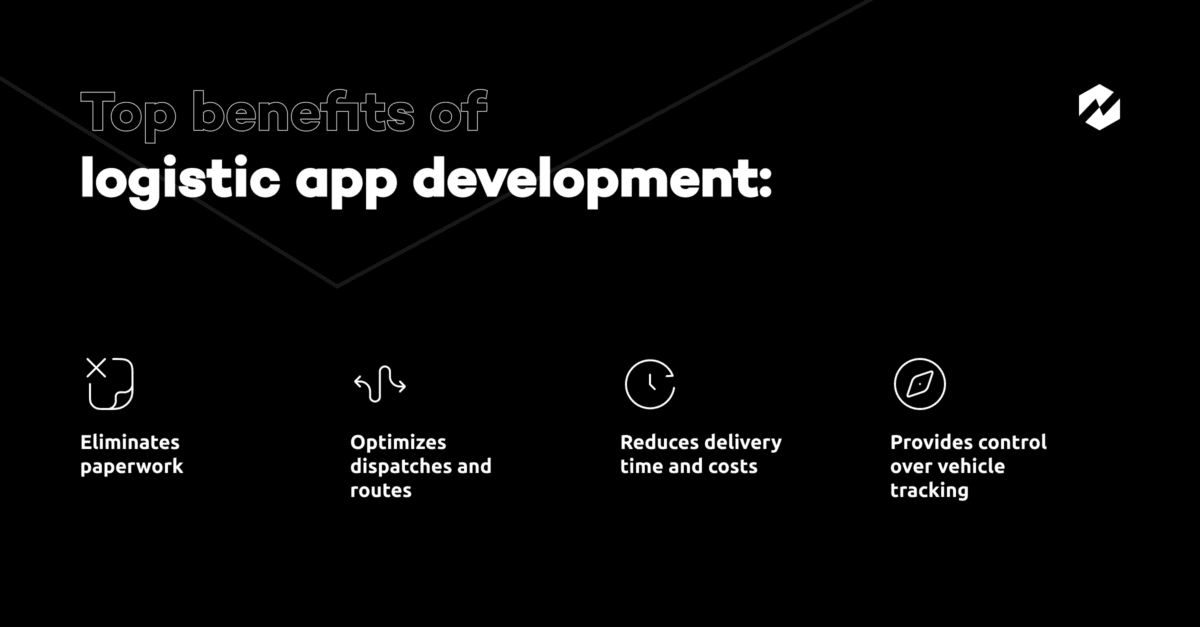

Eliminates paperwork
The use of technology in logistics operations eliminates paperwork, which saves time and money. The elimination of paperwork also reduces the risk of errors associated with completing forms by hand or manually entering information into a computer system. Utilizing an app-based system helps ensure accuracy throughout the entire process.
Optimizes dispatches and routes
Logistic apps are designed to optimize dispatches and routes while saving your company money on fuel costs. This is done by planning efficient routes that help drivers avoid traffic jams as well as providing real-time updates on road conditions so drivers can plan their routes accordingly. Additionally, these apps provide information on alternate routes if needed due to road closures or other unforeseen circumstances.
Reduces delivery time and costs
Logistics app development helps companies reduce delivery times by allowing them to manage multiple deliveries at once while keeping track of progress along each route. This reduces delivery times by ensuring that each driver has access to the most up-to-date information regarding their delivery schedule and location. In addition, these apps can be used to identify areas where cost savings can be achieved, such as reducing fuel consumption or finding better rates from suppliers for parts or materials needed for delivery vehicles.
Provides control over vehicle tracking
By utilizing logistic apps for vehicle tracking, companies can have complete visibility into their fleet’s performance in real time. From where each driver is located to what deliveries they’re making at any given moment – logistics apps provide detailed insights into every aspect of your fleet’s operation for both short-term planning purposes as well as long-term growth strategies.
Read Also: Large-Scale Software Development: Process, Standards, and Risks
How to Carry Out The Logistics App Development in 9 Steps
To make it clearer where to start logistic app development and how exactly this whole process should be built, we have prepared a step-by-step guide for you. Let’s look at each step in more detail:


Step 1: Come up with your logistics app concept
This process begins by coming up with the logistics mobile app concept. This concept should identify the target audience and address their needs, outlining the functionalities and features that will be provided to them.
Once you have established your application’s concept, it’s time to move forward with logistics app development by gathering experts in the logistics sector and app-building teams simultaneously.
At this stage, it is important to take into account any legal requirements that come along with logistics app development, such as data safety measures for customer use. Feature prototyping is also a key step to ensure the perfect functionality of your logistics application and ease of navigation before going live. We will talk about this later.
Step 2: Conduct in-depth product discovery
To successfully develop a logistics app, it is essential to perform an in-depth product discovery. This involves gaining an understanding of the target user, outlining specific goals for the project, and determining the most suitable technologies for ensuring a reliable logistics application.
This crucial step will help define the direction and timeline required for developing an application that meets all client requirements. In addition, product discovery allows both clients and developers to gain insight into the potential risks of logistics mobile app development and determine practical solutions to any potential issues.
Ultimately, when correctly carried out, product discovery ensures a promising logistics application development process that runs smoothly from start to finish.
Read Also: Progressive Web App Cost: Count Your Project In 15 Min
Step 3: Make a list of logistics app features
Then you should create a list of logistics app features. By doing this, you can identify what functionality the logistics app should have to support its users in their logistics management requirements.
Every logistics operation is unique, so thoroughly consider the app features that need to be included for your particular use case. This is important for ensuring users have a successful experience when using the logistics app.
Once the list of features has been created, it can be used as a guide in developing your application.
Step 4: Build scalable logistics app architecture
To ensure that your logistics management app is capable of meeting your end-users needs, creating an efficient and reliable architecture is key.
Doing so will enable scalability – the ability for the logistics mobile app to expand or contract in response to changes in usage or other market conditions. Additionally, a well-planned logistics app architecture will provide you with flexibility and room to experiment and innovate.
Investing time in building a scalable logistics app architecture will pay off when it comes to having a successful logistics app.
Read Also: Offshore Software Development Services: Key Points
Step 5: Move on to UI/UX design stage
After you create a list of necessary features for your logistics app and build the application architecture, proceed to UI / UX design. UI/UX app design typically includes the following steps:
- Research and Analysis: This step involves understanding the target audience, their needs and preferences, and the competition. This can be done through surveys, interviews, and analyzing user data.
- Sketching and Wireframing: This step involves creating rough sketches and wireframes to define the layout and structure of the app. This helps to determine the basic user flow and hierarchy of information.
- Visual Design: In this step, the designer creates the visual design of the app, including the color scheme, typography, and overall aesthetic.
- Prototyping: This step involves creating interactive prototypes of the app, which can be used to test the user flow and functionality.
- Testing and Iteration: This step involves testing the app with real users and making iterative improvements based on their feedback.
- Development: Once the design is finalized, the app can be developed using coding languages such as Swift, Java, or React Native.
- Launch and Maintenance: Finally, the app is launched in the app store and maintained over time with updates and bug fixes.
Overall, UI/UX app design involves a combination of research, design, testing, and development, with a focus on creating a user-friendly and visually appealing app.
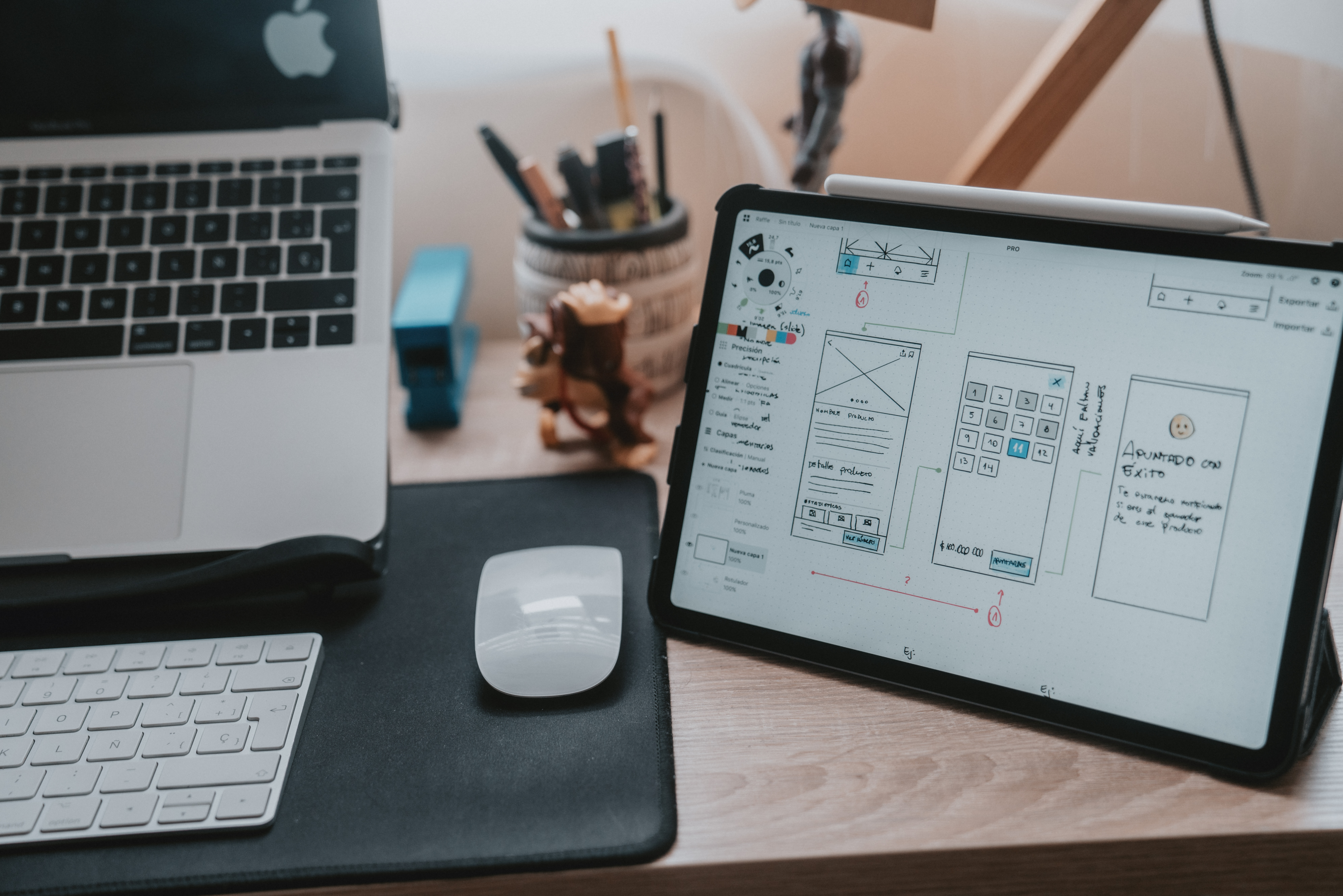

Step 6: Conduct product usability testing
Usability testing helps ensure that the user experience is being met in the most effective way possible. This step is important because it will help you uncover any hidden user issues which might prevent users from having an ideal logistics app experience.
Usability testing looks at a number of key components, such as how user-friendly the logistics app is and if users can complete their tasks with ease. Ultimately, usability testing offers valuable insights into how people interact with the logistics app product and allows for tweaks to be made when needed to create a logistics app that delivers an optimal user experience.
At RewiSoft, for usability testing, we use our own UX lab. We use UX Eye Tracker, which allows for exploring user behavior during interaction with the product. Only 1% of companies use this method. An eye tracker is a unique tool that captures the movement of a person’s gaze and helps get a record of where and for how long the user was looking.
Read Also: Quick Guide to Digital Product Design and Development [Based on 150+ Cases]
Step 7: Start logistics and truck app development
After the design is ready and usability testing is conducted, developers should use the documentation and architecture from previous steps to write code for all the application components. The development part is divided into 2 steps: front-end development and back-end development. At RewiSoft, we usually assign 2+ developers to run this stage. Let’s take a closer look at the main steps of the logistics app development:
- Tech stack & documentation: The first step in logistics app development is selecting the appropriate tech stack and documenting the project requirements, such as user stories, use cases, and functional requirements.
- Software architecture plan: The next step is creating a software architecture plan that outlines the system components, such as the server, database, APIs, and user interfaces.
- Sprints planning: The development process is then divided into sprints, with each sprint consisting of a set of tasks to be completed within a specified time frame.
- Infrastructure setup for testing + CI/CD to the test servers: The next step is setting up the infrastructure for testing and continuous integration/continuous deployment (CI/CD) to the test servers.
- Client and server development & QA: With the infrastructure in place, the client and server development can begin, with quality assurance (QA) testing conducted throughout the development process.
- Regression testing: Regression testing is conducted after each sprint to ensure that new changes do not adversely impact existing functionality.
- Production Infrastructure setup + CI/CD to the prod servers: Once the app is ready for deployment, the production infrastructure is set up, and CI/CD is established for the production servers.
Overall, logistics app development involves a combination of planning, development, and testing, with a focus on creating an app that is user-friendly, scalable, and reliable.
Step 8: Conduct final product testing
At this stage, the team of logistics app developers should thoroughly review all code before delivering it to the customers. Using CI/CD, Integrational Automation Strategy, Regression and Resource Planning as the guideposts, the team will ensure that everything meets strict quality assurance standards.
Step 9: Maintain, launch and support your new app
After the logistics app has been tested, maintained and optimized for peak performance, it’s time to launch the app. This involves announcing the launch and making sure your logistics app is ready to use on the appropriate devices and platforms.
Once launched, you also need to be prepared to provide ongoing support for any issues that may arise. A successful logistics app development process should result in a product that works reliably and efficiently at launch and beyond.
Make sure you take the time to address any early user feedback, as this will help build trust and loyalty with your customers.
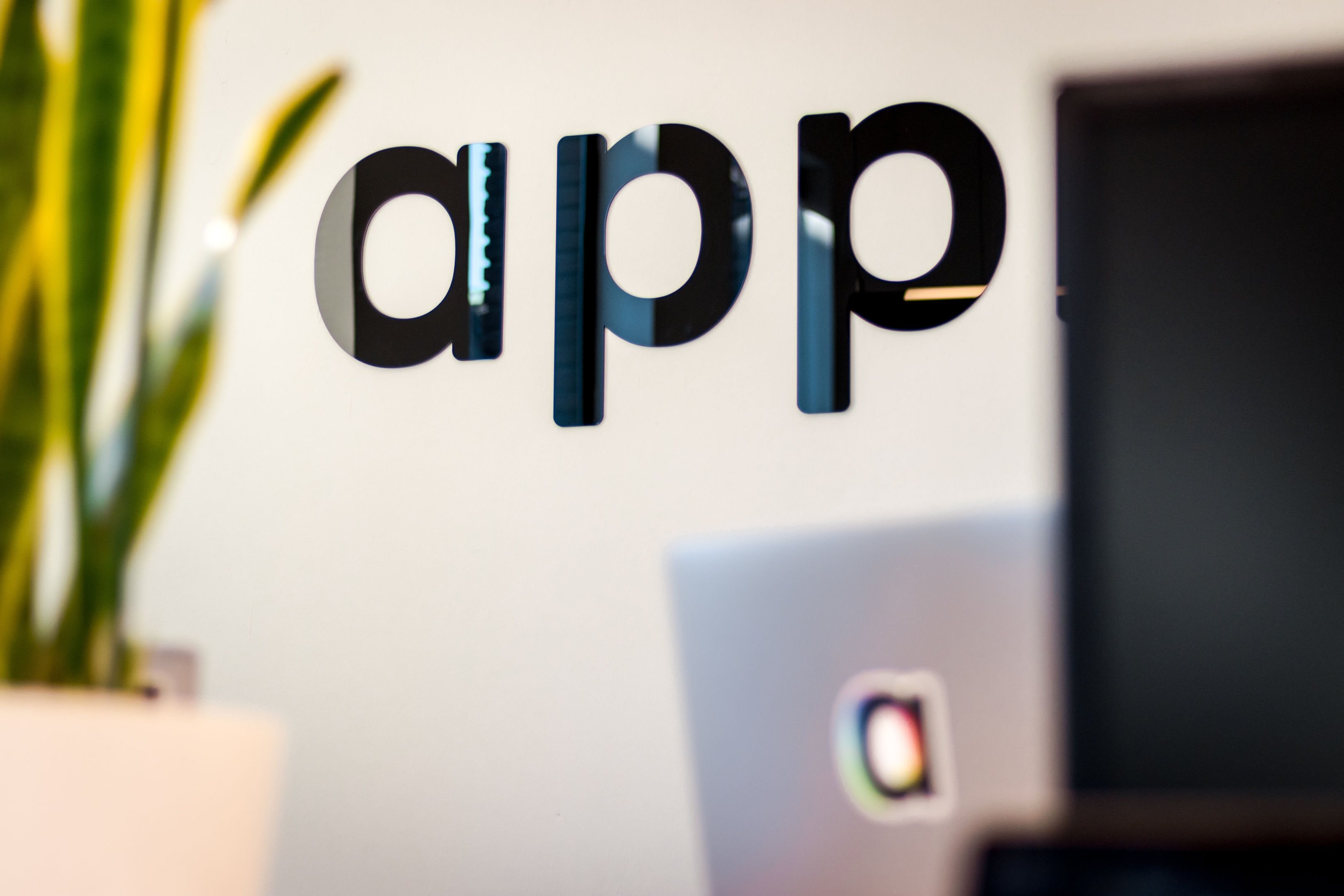

How RewiSoft Can Help You With Logistics App Development
RewiSoft provides high-quality mobile app development services, namely Android app development, IOS app development, Hybrid app development and Flutter app development. At RewiSoft, we are proud to provide our customers with excellent logistics app development services. Our knowledgeable and experienced team is committed to creating custom solutions that best meet the unique needs of logistics businesses.
Our logistics app development process involves many steps in order to maximize the efficiency and effectiveness of our client’s apps. We understand how important it is for logistics businesses to stay organized and connected, and that’s why we go above and beyond to ensure top-quality results from start to finish with our logistics app development services.
One of our clients, Iport, a company that deals with the management of cargo carrying ships, has their own product, CORAL, that is intended for the creation and management of contracts, documents, benchmarks, finance conditions and work with lots of numbers related to the accounting side of the shipping process.
The client needed a professional team of designers who would quickly get involved in the process and work with their development team and project manager. The process had strict timelines and consisted of sprints and demos for all stakeholders.
Here are the main challenges and requirements that were in this project:
- Building a robust information architecture
- Structuring all platform content
- Creating visually appealing UI/UX design
- Ensuring a high level of security
As a result, our team simplified the already quite complex process of creating a contract and also used a multi-level slide for the list with a large number of entities, which helped simplify the process for users. Also, we came up with solutions for better structuring a lot of information and making it easier to use on the platform.
Our team will be happy to help you organize the development process and build a high-quality product that will meet your needs and requirements!
Why Architecture is Important in Logistic App Development
In order for a logistic app to be successful, it must be built on a strong architectural foundation that is both scalable and flexible. Let’s discuss why architecture is essential when developing logistic apps and how architecture can impact scalability, performance, cost, and time:
Scalability and flexibility
Architecture plays an important role in determining the scalability and flexibility of a logistic app. The most successful logistic mobile apps are those that can quickly adapt to changes in user needs or market trends. To do this effectively, developers need to create an architecture that can accommodate new features or components with minimal effort or disruption.
A well-architected system should also have the ability to scale up as needed when the user demands increase unexpectedly due to seasonal events or promotional campaigns. With a scalable architecture in place, developers can easily add new components or features without destabilizing the entire app.
Performance
Architecture also impacts performance when building a logistic app. If the architecture is not optimized correctly, there could be unnecessary delays due to inefficient data handling or slow loading times. Poorly designed architectures can lead to slower response times, which leads to poor user experience and decreased customer satisfaction levels.
To ensure optimal performance, developers must design their architectures carefully so that data retrieval and processing are done quickly and efficiently. Additionally, they should take into account resource utilization when designing their architectures; this will help ensure that resources are used efficiently without compromising performance levels.
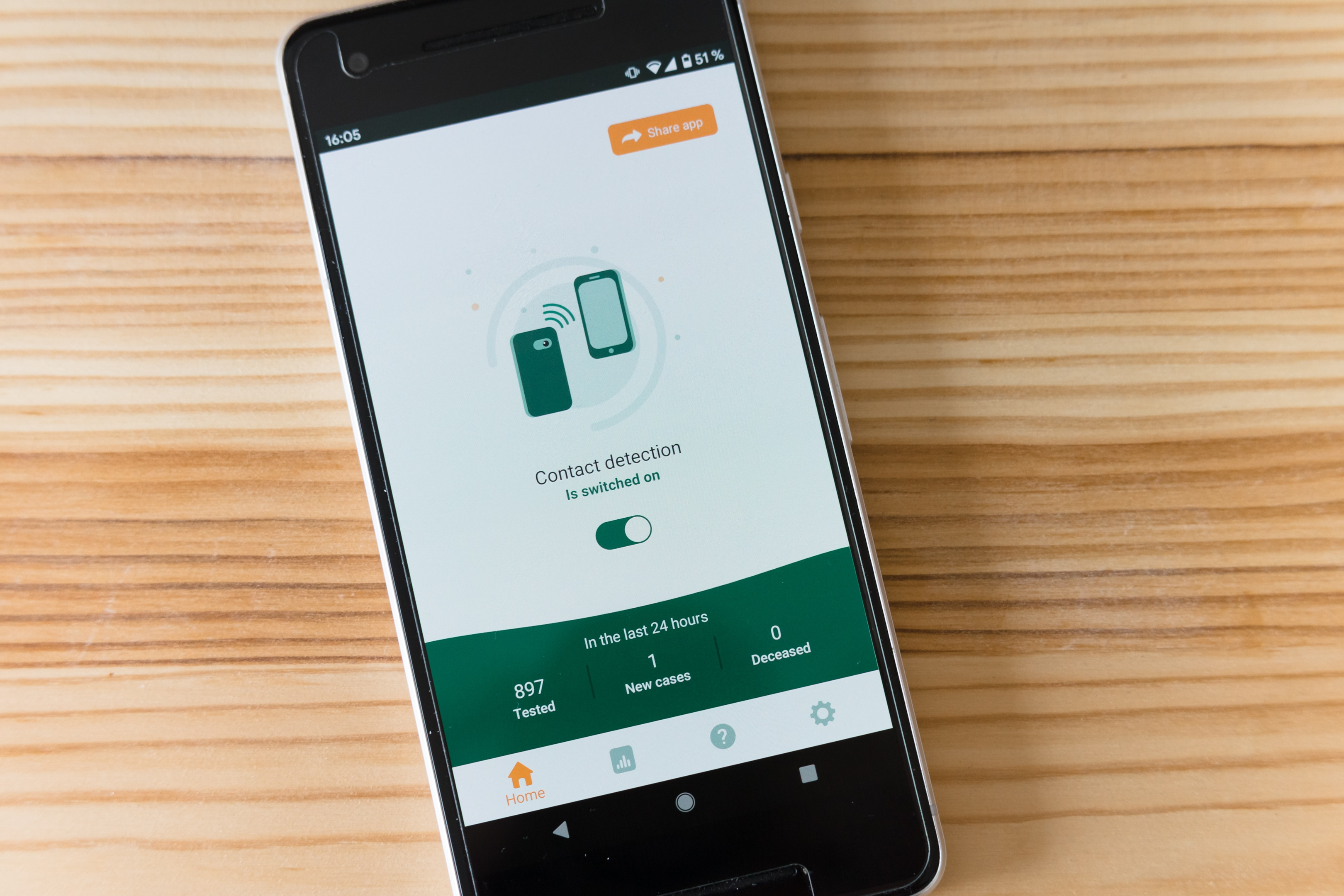

Saved time & costs
Finally, architecture plays an important role in saving time and costs when developing logistic apps. By designing an efficient architecture from the start, developers can avoid costly reworks down the line due to changes in user requirements or market trends. A well-thought-out system also allows for faster development cycles since components can be reused instead of rewritten from scratch each time a change is required.
This helps save time by avoiding unnecessary coding efforts as well as reducing debugging cycles needed for code review processes. All these factors help reduce overall logistics app development costs while still delivering high-quality results within short timelines for customers who require quick solutions for their business needs.
Read Also: Quick Guide to Digital Product Design and Development [Based on 150+ Cases]
Features to Add During Logistics App Development
Let’s discuss the top five features to add during logistics app development:
Real-time tracking feature
The ability to track shipments and deliveries in real time is essential for any logistics app. This feature allows shippers and receivers to have complete visibility and control over the shipment process. It will also enable logistics companies to track the location of their drivers and vehicles, ensuring quick and efficient delivery. Integrating GPS technology into the app will help with the real-time tracking of shipments.
Integration with other systems
Logistics companies use various systems to manage their operations, such as warehouse management systems, transportation management systems, and enterprise resource planning systems. Your logistics app should have the ability to integrate with these systems seamlessly. This will ensure smooth and efficient operations and minimize errors by automating the process.
APIs for customization
The use of APIs in a logistics app is essential for customization. It will enable developers to integrate third-party software and give users a better experience. APIs allow developers to create custom modules for specific users, enabling them to have unique functionalities tailored to their specific needs.
Scanning and documentation
Scanning and documentation features are essential when it comes to logistics. The app should allow drivers to scan delivery notes or barcodes to confirm delivery, providing proof of delivery. Additionally, the app should also generate documentation for the shipment, which could include invoices and receipts.
Push notifications
Providing quick updates and notifications to users is crucial for any logistics app. Push notifications can allow users to stay updated on the status of their shipments and receive alerts when there is a significant change in the shipment status. These notifications can also help drivers stay informed about traffic conditions or potential weather hazards.


What Tech Stacks to Use During Logistics App Development
For a logistics app to truly stand out from the competition, leveraging state-of-the-art technology is key. To develop an experience that exceeds expectations, here is a list of tech stacks to incorporate into every stage of logistics app development:
IOS custom logistics app development
Here is what we recommend to use to develop logistics app for the IOS system:
Language: Objective-C, Swift.
Core: iOS SDK, CocoaTouch / Multimedia.
Analytics: Firebase, Amplitude, AppsFlyer, Facebook.
Data: Realm, CoreData, UserDefaults, KeyChain, CryptoSwift.
Read Also: Ultimate Guide on How to Outsource Mobile App Development?
Android custom logistics app development
For the Android system, we advise your team to use the following for logistics app development:
Language: Java, Kotlin.
Core: Android SDK, Android Jetpack.
Analytics: Firebase, Amplitude, AppsFlyer, Facebook.
Data: Realm, SQLite, Shared Preferences, Room.
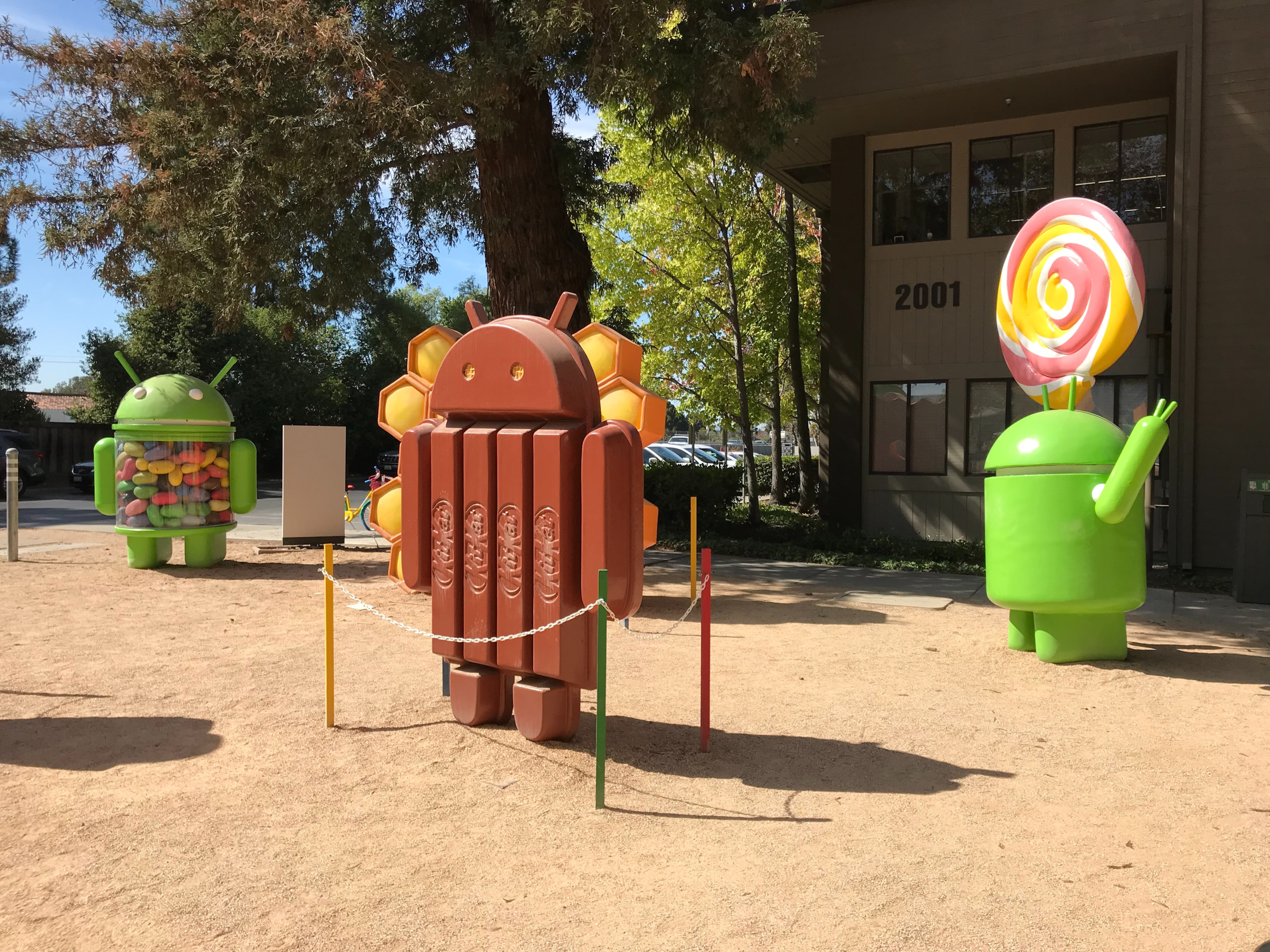

Hybrid custom logistics app development
Hybrid development is gaining a lot of popularity lately. Our team recommends that you use Flutter to create an application that will work great on various types of operating systems. Learn more about Flutter app development here. Our team provides outstanding Flutter app development services, so you can completely entrust your idea to us!
Why Does Logistics App Development Fail
Logistics app development can be a complex process that requires careful planning and execution. Unfortunately, it’s not uncommon for app developers to make mistakes that can lead to failure. Let’s discuss five common pitfalls that you should avoid when developing a logistics app:
Poor UX
User experience (UX) is one of the most important aspects of an app. Users want an app that’s easy to use and understand, so make sure you focus on creating an intuitive design with clear navigation and understandable menus.
Not taking users into consideration
Before you even begin development, it’s important to research what users are looking for in a logistics app. What features do they find most helpful? What type of logistics interface do they prefer? Answering these questions will help ensure that your app meets user expectations.
Too many features
Too many features can be overwhelming for users and slow down your app’s performance. Focus on only the most essential features and ask yourself if each feature adds value to the user experience before including it in your app.
Choosing the wrong type of app
It’s important to choose the right type of transport and logistics app for your project. Do you need a mobile or web-based application? Which platform will best suit your needs? Choose wisely; otherwise, you may end up wasting time and resources on an incompatible solution.
Inexperienced logistics app development team
When selecting a team to develop your logistics app, be sure to check their experience level with similar projects. A team who understands the ins and outs of logistics mobile apps will have better insight into how best to tackle the challenge at hand – and ensure that your project is successful from start to finish.
The Best Team for Logistics App Development
When it comes to logistics app development, it is essential to have a team of highly skilled and experienced professionals. This means that the project manager should be experienced in managing logistics-related projects and have an understanding of logistics software development.
The UX/UI designer should create the best user experience for logistics software and be capable of incorporating industry trends into their design decisions. A reliable and experienced software architect is also needed to ensure that the logistics solution is built on techno-architectural principles.
For the back-end engineering part, a proficient knowledge of databases and back-end platforms such as .NET and Node js is necessary. At the same time, efficient frontend engineers with skill sets in HTML 5, CSS 3, JavaScript, React Native, etc., can make sure that the logistics application stands out among others through its user interface.
Finally, a QA engineer with experience in testing logistics-related applications will ensure that any near-final solution meets specifications set by the stakeholders from a usage perspective. When all these pieces come into play together, only then can one expect successful logistics app development outcomes.
Read Also: How Much Does It Cost to Outsource Software Development in 2023? [Rates, Countries, and Seniority]
Top Monetization Strategies For Logistics App Development
Developing a logistics app can be an exciting venture, but with any development project, you want to make sure that your efforts are worth the hard work. One of the best ways to ensure this is by having a monetization strategy in place. Let’s explore some of the most popular and effective strategies for monetizing your logistics app:
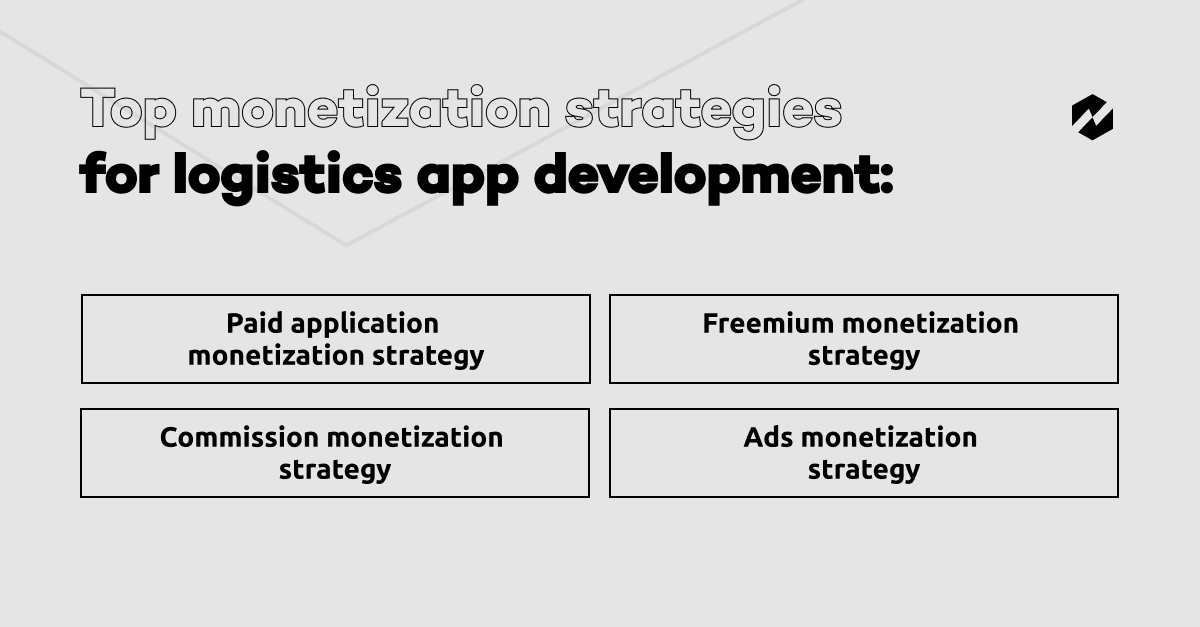

Paid application monetization strategy
The paid application strategy involves charging users for downloading and using your app. This is one of the simplest strategies since it does not require much effort on your part other than collecting the fee from each download.
However, it is important to note that pricing too high could limit your user base, so it’s important to do market research before settling on a price point. Additionally, you may need to provide customer support and updates as needed, which can add time and cost to this strategy.
Freemium monetization strategy
Another common strategy for monetizing apps is freemium, which involves offering a free version of your app with limited features and then charging users for access to additional features or advanced functionality.
The advantage of this strategy is that you can attract more users who are willing to pay for additional features once they get used to the free version of the app. However, you will need to invest more into creating these additional features, so there may be an initial cost associated with this approach.
Commission monetization strategy
A commission-based model involves charging a percentage of transactions when someone uses the logistics app for their deliveries or services. This type of monetization strategy works best if you have partnered with third-party vendors who offer services through the app, such as delivery or storage providers.
You would collect a commission when someone chooses those services through your platform, allowing you to earn money without having to charge upfront fees or create additional features or functionality.
Ads monetization strategy
The last monetization option we will discuss is ads-based monetization, where you insert ads into your app in exchange for payment from advertisers who want their products or services featured in front of potential customers.
Ads-based monetization works best if you have a large user base because this will allow you to charge more premium rates for ad space within your app and increase earnings over time as your user base grows larger.
Read Also: How to Modernize Legacy Applications in 2023? [a Step-by-Step Guide]
How Much Does Logistics App Development Cost
Custom logistics app development at RewiSoft costs from $30,000.
Logistics app development is no small undertaking; developing an effective logistics app requires careful planning, design, development, and implementation to ensure the productivity of logistics operations. Consequently, logistics app development costs can vary significantly based on the size of the project, quality of desired features, type of platform chosen, and many other factors.
It is generally best to consult a professional logistics software company for an accurate estimate. This can help provide clarity on logistics app development costs and make sure you get the most out of your investment.
We prepared a table that will show you how much each logistics app development process costs, depending on the region where the development team is located:
How Long Does Logistics App Development Last
The logistics app development process can take anywhere from a few months to multiple years, depending on the scope of the project. In a few months, you can develop a good MVP with a basic set of features. But if you spend more time, you can develop a full-fledged product with robust architecture and great capabilities. It is important to carefully consider any feature requests and prioritize them according to the business purpose they will serve.
After that, it is important to ensure that extra time is allocated for testing and evaluating the developed logistics app. The timeline of logistics app development also depends largely on the size of the team, the resources available, the experience of the developers, and their ability to troubleshoot any technical issues. With efficient planning and execution, logistics app development can be completed within an acceptable timeframe.
The following table will show you approximately how much time is required for each individual logistics app development process:
Conclusion
In the end, creating an app to support your business needs is a considerable investment of time and money, but the potential rewards are immense.
By opting for logistics application development, you can ensure that your business runs smoothly, freeing up time and resources to focus on growing your customer base. When choosing an app developer for your project, don’t be afraid to ask about their experience in logistics-app creation, so you pick the right fit for your business.
Understanding the mechanics behind developing a dedicated app specifically tailored to your unique needs should also increase your confidence in being successful. With careful planning and preparation, you’ll soon see increased efficiency within your business – and improved financial rewards.
Investing in implementing logistics applications as part of your long-term strategy is one of the most strategic moves businesses can take today and can give you an edge over competitors that choose not to adapt to current trends.







